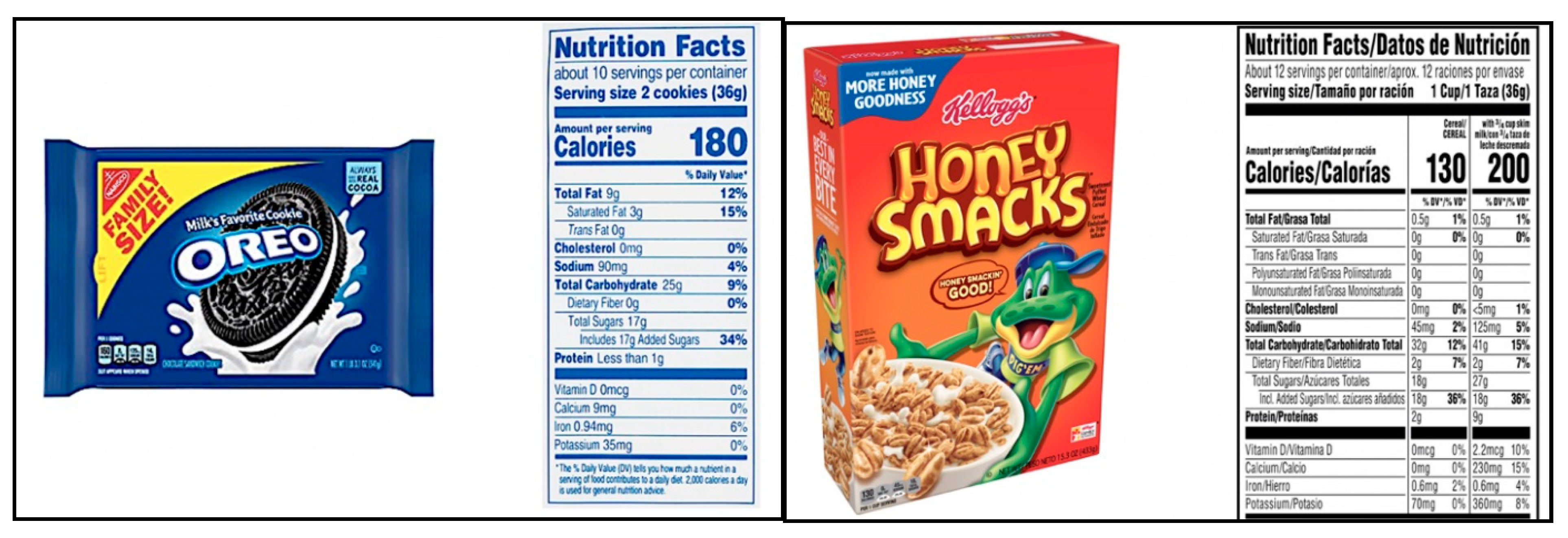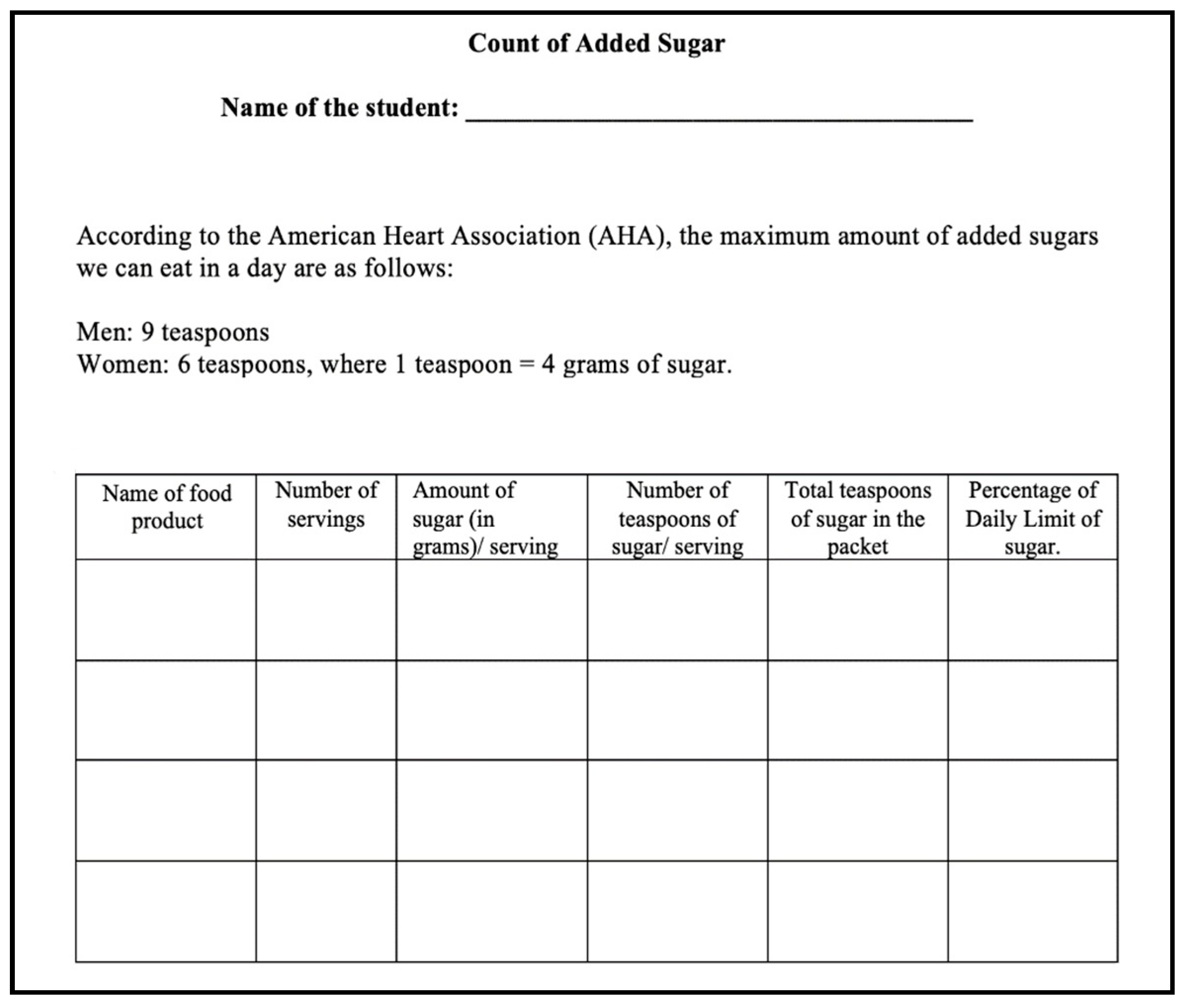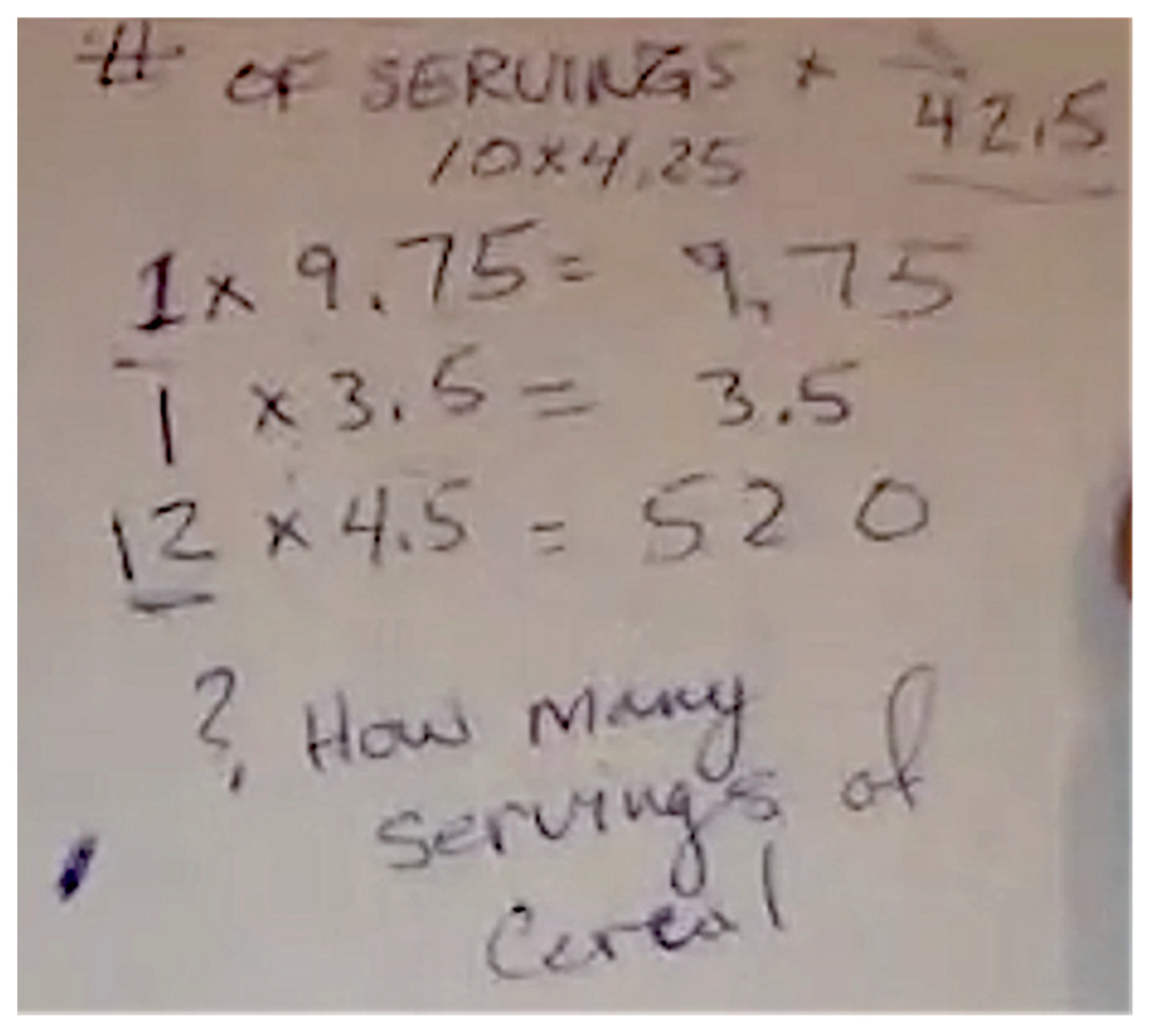Eating Healthy: Understanding Added Sugar through Proportional Reasoning
Abstract
1. Introduction
- Does a task developed on added sugar provide students with a meaningful context to engage in proportional reasoning?
- Does proportional reasoning help students identify the quantity of added sugar present in different food products and thus engage students in a discussion about food quality?
2. Literature Review
2.1. M of STEM: Proportional Reasoning
2.2. S of STEM: Added Sugar
3. Theoretical Framework
- The activity principle advocates that mathematics can be best learned by doing. Freudenthal [35,38] said that ready-made mathematics, through an anti-didactic intervention, cannot be transferred to students. Rather, mathematics can be best learned through an active participation [39]. It provides students with an opportunity to come up with their own strategies and insights to address a real-life situation.
- In addition to students taking agency of their own learning, the second principle of RME emphasizes connecting mathematics to reality. As the reality principle suggests, mathematical learning should not commence from numerical strategies and formulae followed by their applications in real life; rather, our reality should serve the learners with sources to learn mathematics. Instead of beginning with abstractions, Freudenthal [35,38] proposed “didactical phenomenology” in which “one is concerned with describing how a mathematical idea emerges in a learning and teaching process as a means to organize phenomena” [40] (p. 25).
- The level principle refers to the various levels of mathematical understanding and cognitive development that students obtain as they engage with some real-world scenarios to formal mathematical setups. According to this principle, RME bridges the students’ informal experience with pure mathematical knowledge and allows students to construct their own instruction and use their own informal strategies to learn formal math. Thus, students will not only be able to develop their own individual learning path but also mature through the process.
- The intertwinement principle suggests mathematical content domains, such as number, geometry, data, space and measure, algebra, and probability, should be taught together to the extent possible. This enables learners to make comparisons among mathematical tools and to see relationships between topics.
- The interactivity principle indicates that learning mathematics is a personal activity and one that involves interaction with other people. It is the interaction with other people that helps to stimulate and develop a learner’s mathematical abilities. This principle of Realistic Mathematics Education allows for the understanding that mathematics cannot be learned alone; instead, it must develop through social interactions.
- The guidance principle implies that RME teachers should play a more active role in their students’ learning. Mathematical programs should contain scenarios that can help students develop long-term learning trajectories.
Task Design and Analytical Framework-Proportional Reasoning
- Well-chunked measures: Comparison of two extensive resulting in an intensive measure (rate). Example: Speed equals miles per hour.
- Part-Part-whole: The extensive measure of the single subset of a whole is given in terms of the cardinalities of two sub-subsets of which it is composed. Example: Ratio of carbohydrate, protein, and fat in a food product.
- Associated sets: Sometimes, the relationship between two elements is unknown unless their relationship is defined within the problem situation. For example, the connection between teaspoons and sugar/servings is not apparent unless a statement defining the relation between the two quantities is explicitly made.
- Stretchers and Shrinkers: When a continuous one-to-one ratio preserving mapping exists between two quantities, then the situation containing the quantities involves scaling up (Stretchers) or scaling down (Shrinkers).
4. Materials and Methods
The Added-Sugar Activity
- a packet of Oreo cookies,
- a can of Coke,
- a 40 oz container of Chobani Greek yogurt, and
- a 15.3 oz box of Kellogg’s Honey Smacks breakfast cereals.
- Participants and Settings
5. Results
5.1. Task 1
First, we know that one teaspoon is equal to 4 g, and we need to figure out, the 17 g is how many teaspoons… So, basically, what I did was, um, I just said one by x is equal to four over 17 (1/x = 4/17) and cross multiplied them. So, you get 17 is equal to 4x, you divide four on both sides, and you get x is equal to 17 over 4 (x = 17/4).
5.2. Task 2
There are 10 servings per container. (One) serving is two cookies. So, 10 times two is 20 (cookies)…, so two over 20 is equal to 4.25 over x (). Um, we could multiply it, but we could simplify it here. So, there’s one. So, it’s two over 20 (. So, there’s one in 10 (…And we could say that x is …the number of teaspoons in the total would be 10 times 4.25.
Um, because we found a one for one serving, and now we’re just trying to find it for four servings because that’s how many servings there are in a package. So, it’s just one serving plus one serving plus one serving plus one serving is equal to the total cup. So, another way to put that is just, um, the 3.5 times four.
5.3. Task 3
5.4. Students’ Understanding of Added Sugar through Proportional Reasoning
- Interviewer: Would you consider the food products healthy? The four food products?
- Lenny: Um, no.
- Interviewer: Like none of them are healthy?
- Lenny: No, I was noticing, but Chobani had like 14 g of protein and it has same
- 14 g of sugar. So, I guess I could, that could be considered a healthy above
- these three, the other three choices.
- Interviewer: What about Kellogg’s? It is a breakfast cereal.
- Lenny: Yeah. But there’s like 17 and 18 g. I mean the 18 g of sugar. It’s probably not something you should have in the morning.
6. Discussion
7. Conclusions
Author Contributions
Funding
Institutional Review Board Statement
Informed Consent Statement
Data Availability Statement
Acknowledgments
Conflicts of Interest
References
- National Council of Teachers of Mathematics. Professional Standards for Teaching Mathematics; National Council of Teachers of Mathematics: Reston, VA, USA, 1991. [Google Scholar]
- National Research Council. Everybody Counts: A Report to the Nation on the Future of Mathematics Education; National Academy Press: Washington, DC, USA, 1989.
- Rutherford, F.J.; Ahlgren, A. Science for all Americans; Oxford University Press: Oxford, UK, 1990. [Google Scholar]
- Honey, M.; Pearson, G.; Schweingruber, H. STEM Integration in K-12 Education: Status, Prospects, and an Agenda for Research; National Academies Press: Washington, DC, USA, 2014. [Google Scholar]
- Basu, D.; Panorkou, N. Integrating covariational reasoning and technology into the teaching and learning of the greenhouse effect. J. Math. Educ. 2019, 12, 6–23. [Google Scholar]
- Lamon, S.J. Ratio and proportion: Connecting content and children’s thinking. J. Res. Math. Educ. 1993, 24, 41–61. [Google Scholar] [CrossRef]
- Akatugba, A.H.; Wallace, J. An Integrative Perspective on Students’ Proportional Reasoning in High School Physics in a West African Context. Int. J. Sci. Educ. 2009, 31, 1473–1493. [Google Scholar] [CrossRef]
- Howe, C.; Nunes, T.; Bryant, P. Rational number and proportional reasoning: Using intensive quantities to promote achievement in mathematics and science. Int. J. Sci. Math. Educ. 2010, 9, 391–417. [Google Scholar] [CrossRef]
- Cabero-Fayos, I.; Santágueda-Villanueva, M.; Villalobos-Antúnez, J.V.; Roig-Albiol, A.I. Understanding of inverse proportional reasoning in pre-service teachers. Educ. Sci. 2020, 10, 308. [Google Scholar] [CrossRef]
- Hilton, A.; Hilton, G.; Dole, S.; Goos, M. Promoting middle school students’ proportional reasoning skills through an ongoing professional development programme for teachers. Educ. Stud. Math. 2016, 92, 193–219. [Google Scholar] [CrossRef]
- Cramer, K.; Post, T.; Graeber, A.O. Connecting Research to Teaching: Proportional Reasoning. Math. Teach. 1993, 86, 404–407. [Google Scholar] [CrossRef]
- Sowder, J.; Armstrong, B.; Lamon, S.; Simon, M.; Sowder, L.; Thompson, A. Educating Teachers to Teach Multiplicative Structures in the Middle Grades. J. Math. Teach. Educ. 1998, 1, 127–155. [Google Scholar] [CrossRef]
- Nagar, G.G.; Weiland, T.; Brown, R.E.; Orrill, C.H.; Burke, J. Appropriateness of Proportional Reasoning: Teachers’ Knowledge Used to Identify Proportional Situations; North American Chapter of the International Group for the Psychology of Mathematics Education: Tucson, AZ, USA, 2016. [Google Scholar]
- English, L.D.; Halford, G.S. Mathematics Education; LEA: Mahwah, NJ, USA, 1995. [Google Scholar]
- Ben-Chaim, D.; Fey, J.T.; Fitzgerald, W.M.; Benedetto, C.; Miller, J. Proportional Reasoning among 7th Grade Students with Different Curricular Experiences. Educ. Stud. Math. 1998, 36, 247–273. [Google Scholar] [CrossRef]
- Misnasanti Utami, R.W.; Suwanto, F.R. Problem based learning to improve proportional reasoning of students in mathematics learning. AIP Conf. Proc. 2017, 1868, 050002. [Google Scholar]
- Gantz, W.; Schwartz, N.; Angelini, J.R. Food for Thought. Television Food Advertising to Children in the United States; Kaiser Family Foundation: Menlo Park, CA, USA, 2007. [Google Scholar]
- Harris, J.L.; Bargh, J.A.; Brownell, K.D. Priming effects of television food advertising on eating behavior. Health Psychol. 2009, 28, 404–413. [Google Scholar] [CrossRef]
- Cheyne, A.D.; Dorfman, L.; Bukofzer, E.; Harris, J.L. Marketing Sugary Cereals to Children in the Digital Age: A Content Analysis of 17 Child-Targeted Websites. J. Health Commun. 2013, 18, 563–582. [Google Scholar] [CrossRef]
- Rosiek, A.; Maciejewska, N.F.; Leksowski, K.; Rosiek-Kryszewska, A.; Leksowski, Ł. Effect of Television on Obesity and Excess of Weight and Consequences of Health. Int. J. Environ. Res. Public Health 2015, 12, 9408–9426. [Google Scholar] [CrossRef]
- Stanhope, K.L. Sugar consumption, metabolic disease and obesity: The state of the controversy. Crit. Rev. Clin. Lab. Sci. 2016, 53, 52–67. [Google Scholar] [CrossRef]
- Bray, G.A.; Popkin, B.M. Dietary sugar and body weight: Have we reached a crisis in the epidemic of obesity and diabetes?: Health be damned! Pour on the sugar. Diabetes Care 2014, 37, 950–956. [Google Scholar] [CrossRef]
- Popkin, B.M.; Hawkes, C. Sweetening of the global diet, particularly beverages: Patterns, trends, and policy responses. Lancet Diabetes Endocrinol. 2016, 4, 174–186. [Google Scholar] [CrossRef]
- Fryar, C.D.; Carroll, M.D.; Ogden, C.L. Prevalence of overweight, obesity, and severe obesity among children and adolescents aged 2–19 years: United States, 1963–1965 through 2015–2016. In Health E-Stats; National Center for Health Statistics: Hyattsville, MD, USA, 2018. [Google Scholar]
- Follong, B.M.; Prieto-Rodriguez, E.; Miller, A.; Collins, C.E.; Bucher, T. Integrating nutrition into the mathematics curriculum in Australian primary schools: Protocol for a randomised controlled trial. Nutr. J. 2020, 19, 128. [Google Scholar] [CrossRef]
- Hovland, A.; Nordhus, I.H.; Sjøbø, T.; Gjestad, B.A.; Birknes, B.; Martinsen, E.W.; Torsheim, T.; Pallesen, S. Comparing Physical Exercise in Groups to Group Cognitive Behaviour Therapy for the Treatment of Panic Disorder in a Randomized Controlled Trial. Behav. Cogn. Psychother. 2012, 41, 408–432. [Google Scholar] [CrossRef][Green Version]
- James, D.C.; Adams, T.L. Curriculum Integration in Nutrition and Mathematics. J. Sch. Health 1998, 68, 3–6. [Google Scholar] [CrossRef] [PubMed]
- Hyman, B. Integrating math and nutrition education: Teaching with the FDA food label. Am. J. Health Educ. 2008, 39, 113–117. [Google Scholar] [CrossRef]
- Van den Heuvel-Panhuizen, M.; Drijvers, P. Realistic mathematics education. In Encyclopedia of Mathematics Education; Springer: Berlin/Heidelberg, Germany, 2014; p. 525. [Google Scholar]
- Bonotto, C. Realistic mathematical modeling and problem posing. In Modelling and Applications in Mathematics Education; Blum, W., Galbraith, P., Henn, M.N.H.W., Eds.; Springer: New York, NY, USA, 2008; pp. 185–192. [Google Scholar]
- Batlolona, J.R.; Laurens, T.; Batlolona, F.A.; Leasa, M. How Does Realistic Mathematics Education (RME) Improve Students’ Mathematics Cognitive Achievement? Eurasia J. Math. Sci. Technol. Educ. 2017, 14, 569–578. [Google Scholar] [CrossRef]
- Zakaria, E.; Syamaun, M. The Effect of Realistic Mathematics Education Approach on Students’ Achievement and Attitudes Towards Mathematics. Math. Educ. Trends Res. 2017, 2017, 32–40. [Google Scholar] [CrossRef]
- Sevinc, S.; Lesh, R. Training mathematics teachers for realistic math problems: A case of modeling-based teacher education courses. ZDM 2017, 50, 301–314. [Google Scholar] [CrossRef]
- Verschaffel, L.; Greer, B.; De Corte, E. Pupils’ beliefs about the role of real-world knowledge in mathematical modelling of school arithmetic word problems. In Mathematical Beliefs and Their Impact on Teaching and Learning of Mathematics: Proceedings of the Workshops in Oberwolfach; Pehkonen, E., Tomer, G., Eds.; Elementary Secondary Education: Duisberg, Germany, 1999; pp. 138–168. [Google Scholar]
- Freudenthal, H. Revisiting Mathematics Education. China Lectures; Kluwer: Dordrecht, The Netherlands, 1991. [Google Scholar]
- Treffers, A. Three Dimensions. A Model of Goal and Theory Description in Mathematics Education; Riedel: Dordrecht, The Netherlands, 1987. [Google Scholar]
- Fauzan, A.; Slettenhaar, D.; Plomp, T. Traditional mathematics education vs. realistic mathematics education: Hoping for changes. In Proceedings of the 3rd International Mathematics Education and Society Conference; Centre for Research in Learning Mathematics: Copenhagen, Denmark, 2002; pp. 1–4. [Google Scholar]
- Freudenthal, H. Mathematics as an Educational Task; Reidel: Dordrecht, The Netherlands, 1972. [Google Scholar]
- Gravemeijer, K.; Terwel, J. Hans Freudenthal: A mathematician on didactics and curriculum theory. J. Curric. Stud. 2000, 32, 777–796. [Google Scholar] [CrossRef]
- Larsen, S. Didactical phenomenology: The engine that drives realistic mathematics education. Learn. Math. 2018, 38, 25–29. [Google Scholar]
- Burgos, M.; Godino, J.D. Prospective primary school teachers’ competence for analysing the difficulties in solving proportionality problem. Math. Educ. Res. J. 2020, 1–23. [Google Scholar] [CrossRef]
- Dixon, H.; Scully, M.; Kelly, B.; Chapman, K.; Wakefield, M. Can counter-advertising reduce pre-adolescent children’s susceptibility to front-of-package promotions on unhealthy foods?: Experimental research. Soc. Sci. Med. 2014, 116, 211–219. [Google Scholar] [CrossRef] [PubMed]



Publisher’s Note: MDPI stays neutral with regard to jurisdictional claims in published maps and institutional affiliations. |
© 2021 by the authors. Licensee MDPI, Basel, Switzerland. This article is an open access article distributed under the terms and conditions of the Creative Commons Attribution (CC BY) license (https://creativecommons.org/licenses/by/4.0/).
Share and Cite
Basu, D.; Nguyen, H.B. Eating Healthy: Understanding Added Sugar through Proportional Reasoning. Int. J. Environ. Res. Public Health 2021, 18, 12821. https://doi.org/10.3390/ijerph182312821
Basu D, Nguyen HB. Eating Healthy: Understanding Added Sugar through Proportional Reasoning. International Journal of Environmental Research and Public Health. 2021; 18(23):12821. https://doi.org/10.3390/ijerph182312821
Chicago/Turabian StyleBasu, Debasmita, and Hong B. Nguyen. 2021. "Eating Healthy: Understanding Added Sugar through Proportional Reasoning" International Journal of Environmental Research and Public Health 18, no. 23: 12821. https://doi.org/10.3390/ijerph182312821
APA StyleBasu, D., & Nguyen, H. B. (2021). Eating Healthy: Understanding Added Sugar through Proportional Reasoning. International Journal of Environmental Research and Public Health, 18(23), 12821. https://doi.org/10.3390/ijerph182312821





